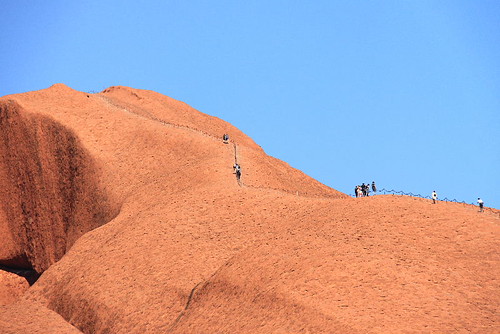
Wanyu Ulurunya tatintja wiyangku wantima
Please don’t climb Uluru
Ulurula tatintjaku tjinguru nguluringanyi
The Uluru climb can be dangerous
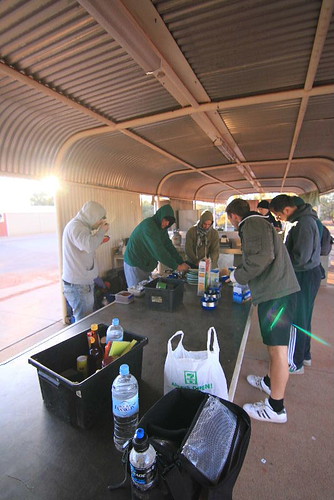
I wake up in the early morning because of the cold air. When we are all waked by Mark and pack up everything, the first destination is Ayers Rock Campground.
Ayers Rcok Resort is the only one place where provides various accommodations includes four hotels, a backpacker hostel (Outback Pioneer Hotel and Lodge) and a campground.
The facilities of the campground are nice. Except for the big clean washing room where you could have a hot bath, every campsite is provided with a sink and the power supply.
Therefore, taking shower and having the breakfast are the first and important things in the morning.
Then we will have a great day in the national park.
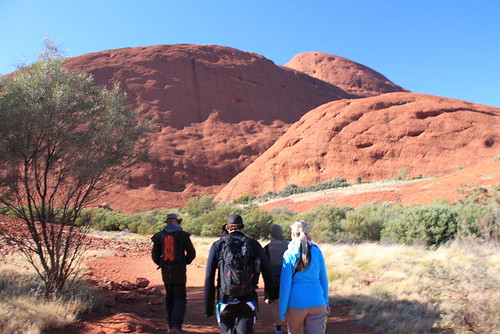
Driving into the national park, the first stop is Kata Tjuta (pronounced as Catta-jaw-tah).
The Uluru-Kata Tjuta National Park was listed as a world heritage natural property in 1987 for its natural importance in geography, plants and wildlife. In 1994, this national park was also listed as world heritage culture landscape for its aboriginal culture.
Kata Tjuta in Pitjantjatjara (an aboriginal language) means many heads. Though it's also called Mount Olga, it's actuall a big group of domed rock formations.
There is a PDF file (Uluru - Kata Tjuta National Park Visitor Guide) from the official website. It could give you a very detialed information about the formation and history of Kata Tjuta.
The highest point, Mount Olga, is about 1066 metre high.
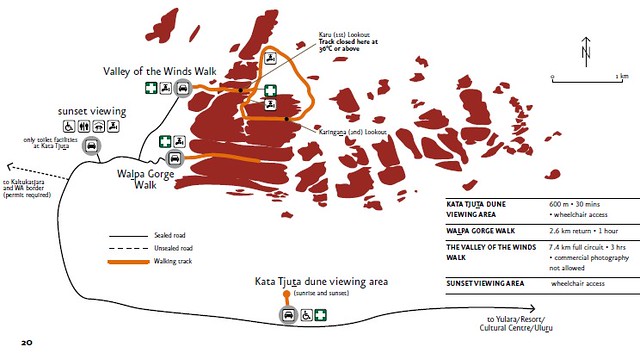
Since Kata Tjuta is the part of the national park, be aware of keeping your steps on the specific route.
Besides, Kata Tjuta and Uluru are both sacred to aboriginal people. According to the men's law, some area are prohibited from entering.
The trecking routes shown as the map above are two. Walpa Gorge Walk is the short one and take about one hour.
Another route we will walk is the Valley of the Winds Walk. The totoal distance is about 7.4 km, and it takes about 3 hours.
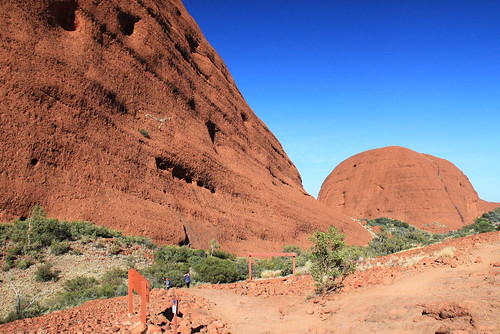
The beginning of the treck is still easy for evryone. After the instructor, we descend along the dome to the frist rest area where Mark tells us a legend about the formation of Uluru and Kata Tjuta.
The legend said, two boys collected lots of soils to make the Uluru. Then they picked up the rocks and threw the rocks behind. These rocks formed Kata Tjuta. The boys played happily and slipped from the top of Uluru. The scratches were left from top to bottom.
Well, that is a story to let you understand easily about the differece in the formation between Uluru and Kata Tjuta.
In geography, Uluru is a whole huge rock.
How big is it? Mark says, the Uluru we see is only a small part of it. Uluru like the iceberg. Most of the rock is hidden under the ground.
As for Kata Tjuta, it's a group of domed rocks.
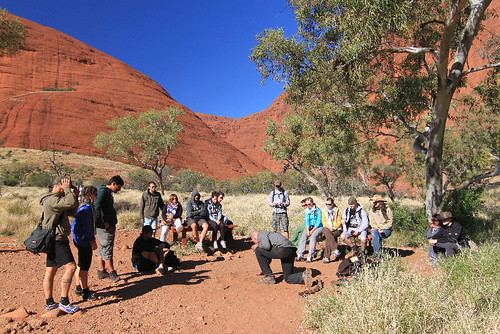
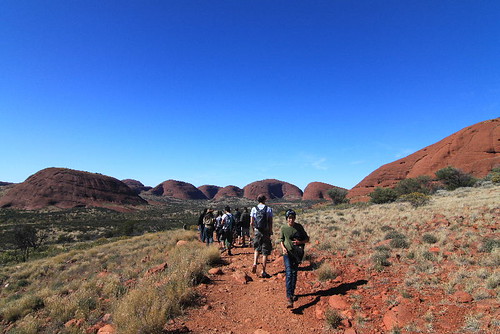
We continue our walking northwards. Though it's still easy, the weather is pretty hot.
Mark waits us at the valley of the wind by going another shortcut.
The road toward the domes is quite long. You may be cheated by the image and think the domes should be near. However, that's because the rocks are big.
When reaching the domes, the valley between two domes is called the valley of the wind.
Just as I think the walking today is easy, the situation changes when I see the steep slope to the top.
Even I've experience the heart-attacking hill of King's Canyon, climbing to the top is still tiring for me.
Karingana Lookout is the top point in the valley.
After climbing to the lookout, the scenery is indeed special. You could feel how huge the dome is and watch the domes far away.
No doubt, it's a excellent place to take the picture. Many tourists take speical photos of themselves in different poses.
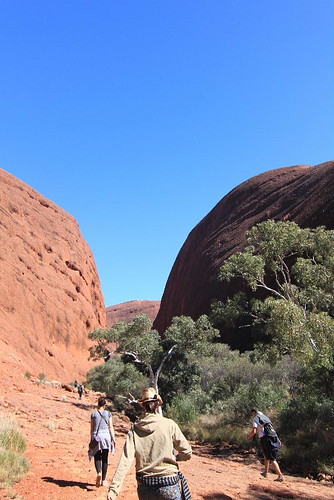

Since the hardest part is finished, the rest becomes easy as the beginning.
Descending to the bottom is a easy job to me even the slope is steep.
There is an interesting wall that looks like an elephant on the way returning to the car park.
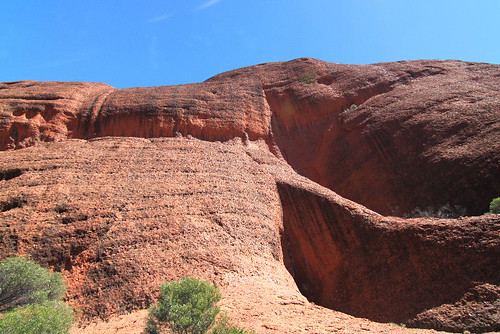
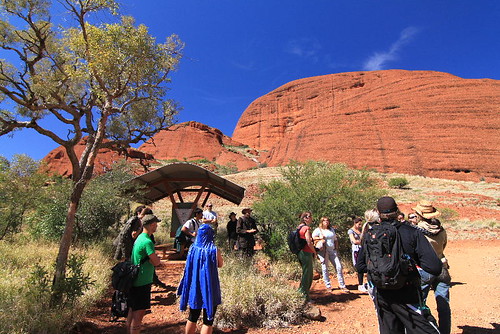
On th half way as we walk to the rest area with water supply, Mark tells us something about the life of aboriginal people.
Actually, aboroginal people know well of the plants in the surrounding.
For example, the needle-like leaves of the tree could be used in the medical purpose.
The bark of another trees is used to make the big bowl which would be placed on women's head with food.
Just as ipi-ipi, the milky sap from a specific tree could be their sun cream.
When refering to the problem of the bush fire, aboriginal people will divide the land into many sections. When they finish hunting in one section, they will burn this section in advance. This burnt section will become safe as they encounter the fire in the section nearby.
Anyway, these knowledge is why they could live in such a cruel environment so long.

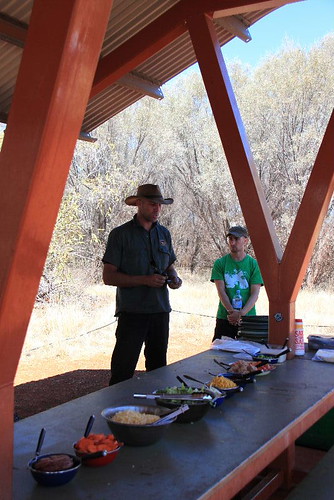
Returning to the car park, the lunch is the wrap with various kinds of vegetables, tuna and cheese.
I find a small yellow bird around our table. Maybe the bird wants some food too.
However, I will appricate more if there is a shop I could buy some ice drinks.
The weather is too hot for me.
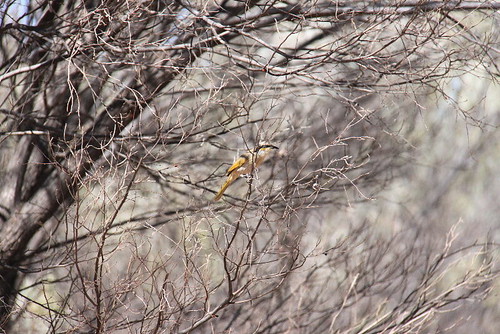
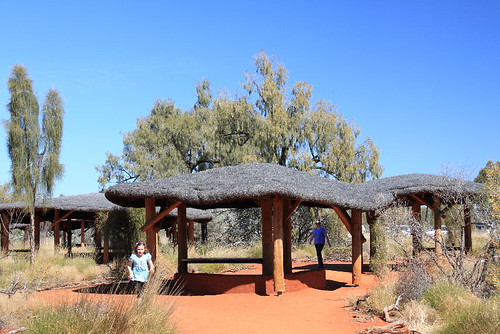
In the afternoon, the next destination before Uluru is Aboriginal Cultural Centre.
Except for the washing room, it's not a good time to walk around Uluru under the big sun.
The center demosatrates plentiful aboriginal culture included the history, life, facilities, nature and etc.
You could buy aboriginal artworks or souvenirs here, but I prefer to have an ice cola.
Because photographing is prohibited inside, I don't have the chance to record their exhibition.
However, the resource from the official website of the national park will provide you the information of aboriginal culture.
I organize the information from Wiki and something I heard from others to make a simple introdution of the aboriginal people.

Aboriginal people is not a specific species of people. Such as the aboriginals in Tasmaina, they could be classified into nine groups includes many branches that lived in different areas.
In Cetral Australia, the aboriginal people is called Anangu (pronounceed as arn-ang-oo).
Anangu people are distributed in the desert regions of west and central Australia and thus the language they spoke is called Western Desert Language (WDL).
More precisely, Anangu means "human being" before the arrival of non-aboriginal people. After that, Anagu is referred to aboroginal people only. Besides, Anangu could means the human body or the dead body.
As for the language, it includes many dialects and the people who speak Yankunytjatjara or Pitjantjatjara are large in number.
In 1981, the Parliament of South Australia passed the Anangu Pitjantjatjara Yankunytjatjara Land Rights Act (abbreviatted as APY) and formed a council. Then, the prject "Ara Irititja" of APY commenced to identify, copy and eletronically record the historial materials about the Anangu.
The project does not only preserve the aboriginal culture, but also provide the resource for cultural delivery. The tourists could also repect the aboriginal culture by understanding more about their culture.
Besides, the national park and culture center also prvide the opportunity of jobs for Anangu.
Nowadys, though Ananu learns about the technical produects, most of them still live in the traditional way.
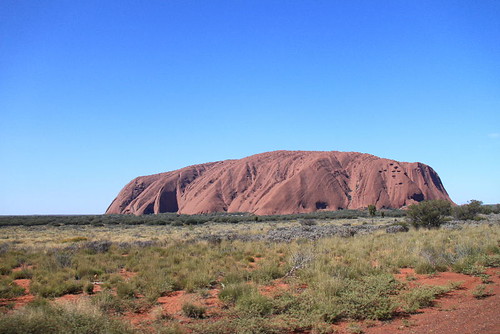
After the short stay in the cultural center, my favorite attraction, Uluru, is coming.
It will be very regretful for leaving central Australia without visiting Uluru.
There are three walks around Uluru: Uluru Base Walk, Lungkata and MALA WALK.
Along these walks, you could observe the details of geographical structures that you could not find in the far location.
Except for these three walks, Kuniya Walk is the shortcut for going to Mutitjulu Waterhole. It takes less than an hour. If you have plenty of time, you could follow Liru Walk from the cultural center to the car park of Mala Walk.

Due to the time, we will walk the Mala Walk today and finish the rest tomorrow.
When we stop at the car park of Mala Walk, I see some tourists climbing Uluru.
I wonder why they want to climb this dangerous rcok jst for boasting.
What is the meaning for climbing Uluru? You have to think about it.
For me, I don't think it's worth to climb Uluru just for watching the scenery on the top.
The climbing is dangerous for sure and many tourists died because of it.
Besides, there is another way to watch the scenery such as taking the helicopter (though the cost is high, it's safe) or viewing from the window of your flight to other city.

The document from the official website also tells you why it's not recommended to climb Uluru.
And the reasons could be descibed in three aspetcs.
The first is the cultral reason: Uluru is an sacred place for Anangu.
Though Anangu doesn't oppose strongly againt climbing Uluru and the law doesn't prohibit the climbing, we should repect the law and the culture of Anangu. It's their home, not yours.

The second is the security and responsibility. For the aboriginal people, they think they are responsible for the security of the tourists. Du to such resonsibility, they always feel sad when someone was injured or dead because of climbing Ulurur.
In the past, there were about 35 people (or more) who died (or were injured) beacuse of the climbing.
Thereforer, if you have a strong reason ofclimbing Uluru, please be careful of your safety.

Finally, the environmental affect is the most important reason I think.
The surface of Uluru has become smooth because of your steps on it. It means that Uluru is eroded by your walking. What would Uluru be if there are thousands of tourists climbing Uluru every year?
In addtion, the worse is someone consider Uluru as the highest toilet in the world.
The waste included the tissue will be washed down to the waterhole at the bottom after raining.
The pollution is harmful to the nature and afftects the wildlife and aboriginal people.
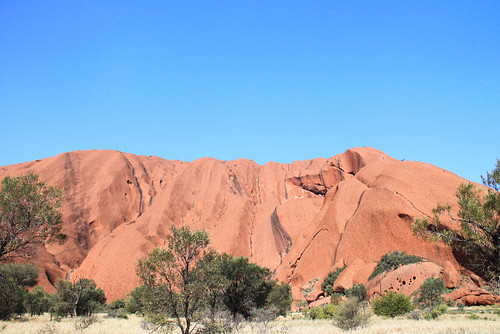
A word in the document is quite good: "It’s not the real thing about this place. The real thing is listening to everything."
Our guide, Mark, says: "every rock could be Uluru."
The reason why Uluru is Uluru is its spiritual meaning to aboriginal people.
How big it is is not the main point.
Many people many see Uluru in the TV, magazine or other meida. However, they don't know Uluru very well.
It reminds me that the same problems also happen in my country.
The attraction that is not popular before becomes very popular suddently and crowed with tourists just becausce of a new facility such as a Sky Walk.
However, the main point should be the scenery itself, not the bridge.
Before the birdge is built, the scenery is already there.
Since climbing Uluru is not the main point of visiting Uluru. Why do you insist to do so?
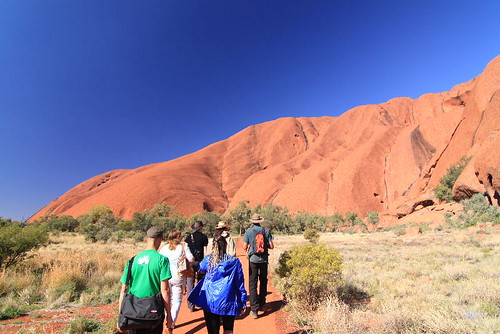
Mark is really a good guide. He is not only the driver, but also a good teacher telling us lots of things about aboriginal culture.
On the half way, he draws apboroginal patterns on the ground.
The concentric circles represent Uluru and Kata Tjuta.
Why the circles are concentric? That is because these mountains look different in size according to the place you watch them.
As for the line, it represent the walk of Anangu. For example, if they walked from Kata Tjuka to Uluru, there will be lines connecting Kata Tjjuta and Uluru.
The snacks, lizards or kangaroos are represented by their footsteps and the spear means hunting.


By the way, Uluru - Kata Tjuta National Park Visitor Guide also intorduce an aboriginal artwork "Working Together"
The red circle (the inner one) in the center is Uluru–Kata Tjuta national park and the twelve "U" shapes are the seats.
You will find the white pattern of shoes that represents the white man fro Europe and the reed pattern of footprints represents Anangu.
Therefore, it means that four of twelve people are white man amd the rest are aboriginal people.
As for the outer red circle surrounding the seats is the tradiotional windbreak called "yuu" and it also means the protection of the decision and policy made by white man and aboriginal people for this national park.
The brown circles and the outer circles also represent the aboriginal's law and the conservation Act that provide the protection and support for the management of the national park.
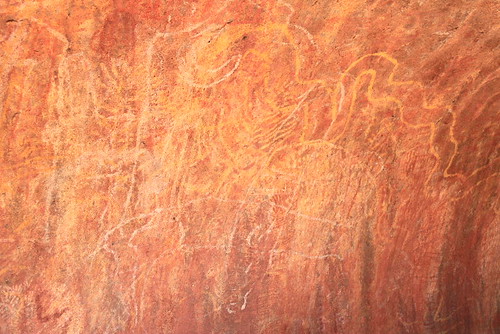
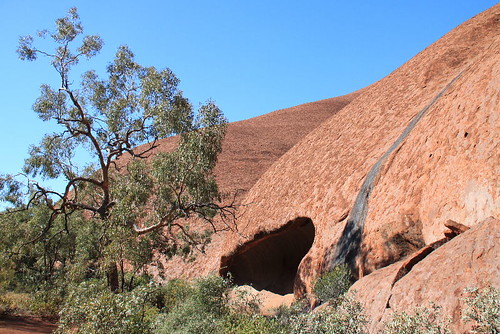
Around Uluru, you could find some drawings on the rock and the geographic structures is also worthy of observing.
Except for the stones and caves, the most strange one should be the black traces from the top.
Actually, the traces were formed by the washing of the water from the top.
Mark talks another interesting story about the name of Kangaroo during the break.
In aboriginal language, Mala means Wallaby and Kangaroo is Malu.
Two people encountered the kangaroo but they didn't know the name. Thus, they asked the local what the creature is called. The local answer "Kangaroo" which means "I don't understand you".
So, you will be fuuny if you say the word "Kangaroo" to Kangaroo.
However, this story is a myth.
In the 1970s, linguist John B. Haviland debunk this myth by the research with Guugu Yimithirr people.
Kangaroo is really referred to the creature itself, a grey kangaroo, in Guugu Yimithirr language.
The myth is just for fun!

Finally, Mark explain the meaning of the aboriginal word "Tjukurpa". (I've really learned a lot!)
He plays a message-passing game with us.
The first message spoke by Mark will be passed one by one.
You may guess what the messgae will be when passed to the last person.
Yah, the message is no more the same message in the beginning.
What is the meaning of this game related to Tjukurpa?
Tjukurpa is the foundation of aboriginal culture and the aboriginal people follow Tjukurpa as the way they live together and behave.
Though someone translated Tjukurpa as "Dreaming" or "Dreamtime", Tjukurpa is not unreal or a legend.
Tjukurpa has many complex meanings. It's their knowledge, their law and their faith.
Tjukurpa is delivered in the forms of song, dance, story and ceremony.
Therefore, Tjukurpa must be delivered very exactlyand strictly to the next generation.
If something was lost, the hunting may fail. In the desert region, it means thay they may die.
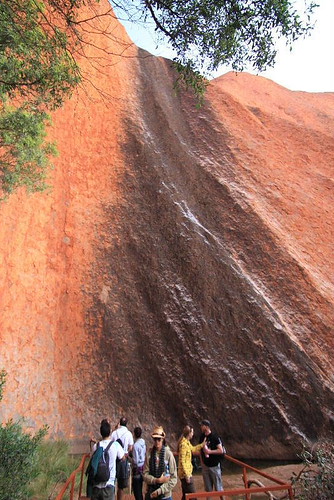
At the end of Mala Walk, there is a waterhole called Kantju Gorge.
It's interesting to watch the gorge by lying on the ground.
And the next is watching the sunset of Uluru.
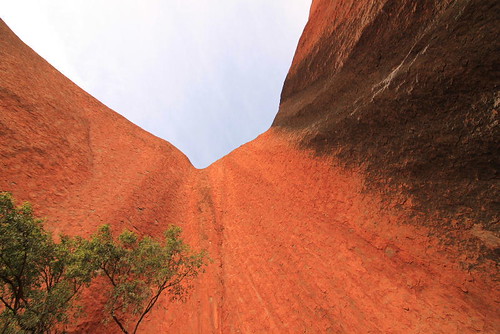
According to the map, there are two viewing areas for watching sunrise and sunset of Uluru.
Most of the tourist bus will stop at the area located in the northwest of Uluru.
Another is "Talinguru Nyakunytjaku" located in the southeast of Uluru.
At the first viewing area, the sun is behind us in the sunset time and you could watch the change of sunlight on Uluru.
If you drive by yourself, you have to think of what the photo you want to take, and choose the proper viewing area.
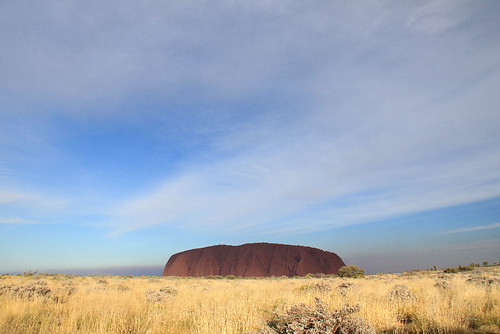
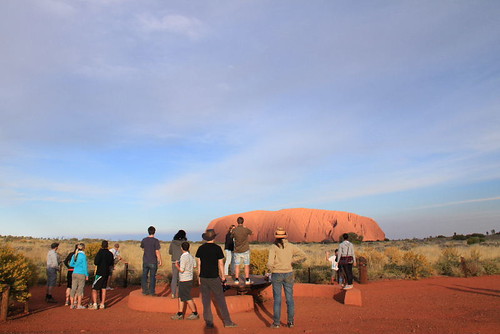
When we arrive at the viewing area, there are already lots of tourists waiting here.
No doubt, it's the photo time.
You could take photos of Uluru under different condition of sunlight.
You could take some crazy photos of yourself with your imagination of Uluru.
I aslo take photos of other members if I feel the frame in my mind is good.
In Iceland, I didn't focus on photographing of people. However, the trip to Uluru is so remarkable that I want to have some pictures for memory
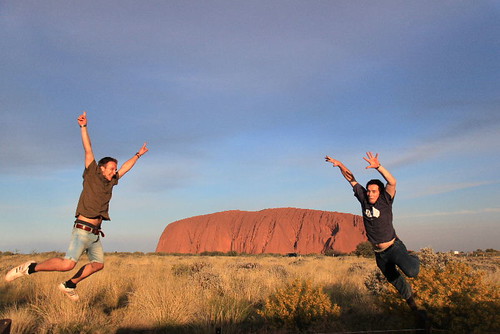

Just as we take pictures, Mark left for a while and brings another tourists back.
It seems that they have a problem on their car.
After that, we enjoy the dinner at the viewing area.
Ha ha, I see the Crested Pigeons around the car. Maybe our food attracts their attention.
But I still think that Spinifex pigeon is the most cute pigeon to me.

In the night, we gather around the campfire on our swags.
As for Mark, he is busy in handling another car.
I'm not sure very clearly about the masfunction of another car, but it's fine that they could fix the car in the resort.
At the last night of the Uluru trip, I still don't know what to talk with others.
It's unlike the tour in Kangaroo Island, I'm the only one person speaking Maderin and limited English.
Besides, my cold seems to be a reason that makes my mind confused when I try to talk something.
Howver, this is not the strangest thing tonight.
Seating between two group of Italians when they are chatting in Italian should be the strangest thing to me.
I even don't know why my swag was placed there.
Anyway, that is also not a matter, though it's a little funny.
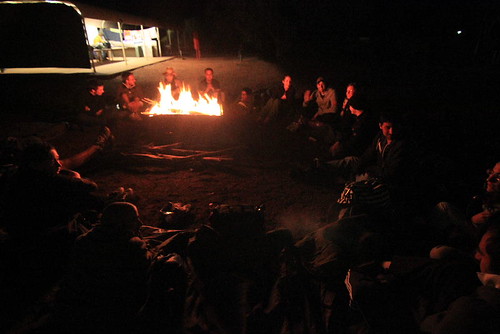
References:
http://www.ayersrockresort.com.au/
http://en.wikipedia.org/wiki/Kata_Tjuta
http://www.environment.gov.au/parks/uluru/
http://www.environment.gov.au/parks/uluru/publications.html
http://www.environment.gov.au/parks/publications/uluru/video/working-together.html
http://en.wikipedia.org/wiki/Kangaroo
http://en.wikipedia.org/wiki/Anangu
http://en.wikipedia.org/wiki/Anangu_Pitjantjatjara_Yankunytjatjara
http://en.wikipedia.org/wiki/Yankunytjatjara
http://en.wikipedia.org/wiki/Pitjantjatjara_people
http://en.wikipedia.org/wiki/Yankunytjatjara_language


 留言列表
留言列表
